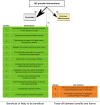A Severe Lack of Evidence Limits Effective Conservation of the World's Primates
- PMID: 32973409
- PMCID: PMC7498340
- DOI: 10.1093/biosci/biaa082
A Severe Lack of Evidence Limits Effective Conservation of the World's Primates
Erratum in
-
Corrigendum: A Severe Lack of Evidence Limits Effective Conservation of the World's Primates.Bioscience. 2020 Nov 13;71(1):105. doi: 10.1093/biosci/biaa143. eCollection 2021 Jan. Bioscience. 2020. PMID: 33442330 Free PMC article.
Abstract
Threats to biodiversity are well documented. However, to effectively conserve species and their habitats, we need to know which conservation interventions do (or do not) work. Evidence-based conservation evaluates interventions within a scientific framework. The Conservation Evidence project has summarized thousands of studies testing conservation interventions and compiled these as synopses for various habitats and taxa. In the present article, we analyzed the interventions assessed in the primate synopsis and compared these with other taxa. We found that despite intensive efforts to study primates and the extensive threats they face, less than 1% of primate studies evaluated conservation effectiveness. The studies often lacked quantitative data, failed to undertake postimplementation monitoring of populations or individuals, or implemented several interventions at once. Furthermore, the studies were biased toward specific taxa, geographic regions, and interventions. We describe barriers for testing primate conservation interventions and propose actions to improve the conservation evidence base to protect this endangered and globally important taxon.
Keywords: IUCN SSC Primate Specialist Group; conservation interventions; effectiveness; evidence based.
© The Author(s) 2020. Published by Oxford University Press on behalf of the American Institute of Biological Sciences.
Figures





References
-
- Berthinussen A, Richardson OC, Altringham JD. 2014. Bat Conservation: Global Evidence for the Effects of Interventions. Pelagic.
-
- Chapman CA, Bonnell TR, Gogarten JF, Lambert JE, Omeja PA, Twinomugisha D, Wasserman MD, Rothman JM. 2013. Are primates ecosystem engineers? International Journal of Primatology 34: 1–14.
-
- Christie AP, Amano T, Martin PA, Shackelford GE, Simmons BI, Sutherland WJ. 2019. Simple study designs in ecology produce inaccurate estimates of biodiversity responses. Journal of Applied Ecology 56: 2742–2754.
-
- Christie AP, Amano T, Martin PA, Petrovan SO, Shackelford GE, Simmons BI, Smith RK, Williams D, Wordley CFR, Sutherland WJ. 2020a. The challenge of biased evidence in conservation. Conservation Biology doi:10.17863/CAM.52118. - PubMed

